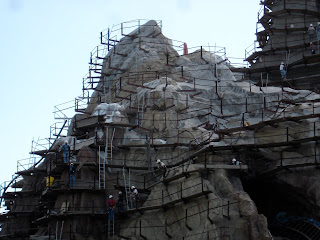On the morning of April 22, 2003, during the Disney's Animal Kingdom 5th anniversary celebration, Imagineering executive designer Joe Rohde took the stage to discuss how far the park had come and make a major announcement about its future. That was the day he revealed the first details about Expedition Everest: Legend of the Forbidden Mountain, set to open in Spring 2006.
For nearly three years, anticipation for the new attraction grew as Guests visiting the park began to see the first construction walls appear in Asia. They knew something was afoot...
It wasn't long before Disney was "Taking Adventure to New Heights," and the steel superstructure of Florida's latest mountain started to peek over the fences.
One of the first elements of the project to be completed was the bridge from Theater in the Wild, leading to a new pathway into Asia. Not only did the path open traffic flow in this area of the park, but it also allowed Guests to see Everest's construction up close.
Excitement built as earth was moved, the foundation was poured, and the mountain went vertical. And then we saw it... the first pieces of twisting steel that were to be part of the track for the ride. One could only wonder how it would all come together.
As it turns out, it wouldn't come together at all. Expedition Everest is actually an extraordinarily complex attraction, comprised of three separate structures that interweave with one another but never touch: the rigid mountain, the flexible coaster track and the dynamic figure of the yeti itself.
As time went on, Expedition Everest grew larger and larger, finally topping out as the tallest (from ground level) mountain at Walt Disney World.
The photos above and below provide fascinating glimpses into different stages of the construction process. Exterior scaffolding was required in order to complete all the detail work on the mountain, but an ordinary scaffold structure would have been impossible to build at this scale. Instead, connection points were built into the mountain where the scaffold supports could be attached. As each layer was completed and removed, it was a simple patch job to disguise the evidence.
Look closely at the picture above, and you may also notice a train on the track leading up from the stone fortress. It's actually just a partial train (only the back two cars), populated with plywood cutouts to represent passengers, and it's being tugged along the track manually by a pair of Imagineers. At this stage of the project, it was important to bring a train through to check for clearances, ensuring that none of the rockwork or other show elements would come too close once the ride was in operation.
April 7, 2006, nearly three years from the date it was announced, Expedition Everest sent its first trainload of passengers across the Forbidden Mountain on their way to ascend the highest peak on Earth. Did they make it? Or are the local legends about the yeti, fierce protector of the mountain, in fact true? We may never know... unless we decide to make the trip ourselves.











With all of the attention to detail, why is the backside left unfinished? Approaching the park, you see what looks like a warehouse with a mountain facade on it. It really destroys the illusion.
ReplyDeleteWhen you approach the mountain from inside the park... it's amazing! I can't believe how it looms over everything.
Kevin,
ReplyDeleteThat's a great question. The basic answer is that it was done to control costs, putting the money into the show as seen inside the park. At WDW, the vastness of the property has for the most part allowed Disney to hide those unfinished backsides of attractions. If you visit Disneyland in Anaheim, you'll see the backs of the show buildings for attractions like Splash Mountain and the Haunted Mansion as you head down Disneyland Drive.
Next time you're at Animal Kingdom, though, look closely at Expedition Everest from the parking lot approach. You'll see that it's not completely unfinished. An effort has been made to make the side of the structure look like an ancient monastery with the mountain peaks above and behind it.
Shawn